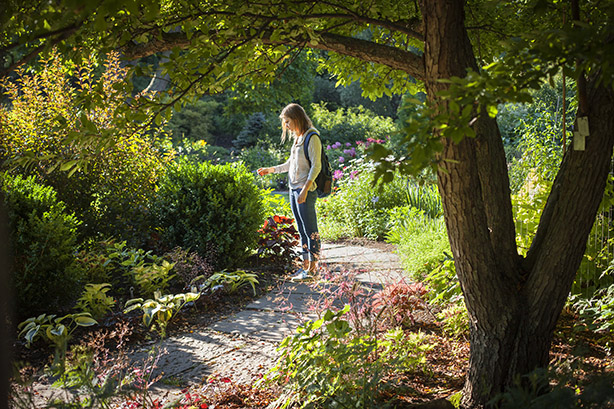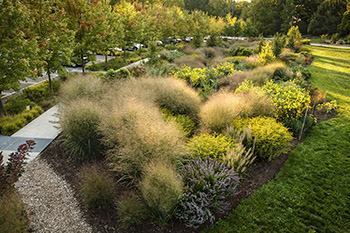From The Collections

The Young Flower Garden highlights plants of cultural significance.
Growing forward: Cornell's unique living collections
Cascadilla and Fall Creek Gorges, Beebe Lake, Comstock Knoll, F.R. Newman Arboretum, the Robison York State Herb Garden and Mundy Wildflower Garden – these are just a few of the iconic landscapes that distinguish the campus and are treasured by Cornellians and Ithacans alike. Now with a new name and broader mission, Cornell's living museum of plants is gaining international accolades for its horticultural beauty and its leadership in environmental conservation and education.

The Bioswale Garden is as hard-working as it is beautiful, and one of the key landscape features that helped earn Gold LEED certification for the Nevin Welcome Center at Cornell Botanic Gardens. Photo: Chris Kitchen. See larger image

The Robison Herb Garden in the heart of Cornell Botanic Gardens is its oldest and most frequently used garden. See larger image

Best College Reviews named Newman Arboretum as No. 1 in their 2015 list of "The 50 Most Beautiful College Arboretums." Photo: Jay Potter. See larger image
Last fall the board of trustees officially approved Cornell Botanic Gardens as the new name for the university's world-class arboretum, gardens and natural areas, originally called the Cornell University Arboretum and known since 1944 as Cornell Plantations. Christopher Dunn, the Elizabeth Newman Wilds Executive Director, views the change as an opportunity to promote and strengthen the relevance of this distinctive university asset and its mission, "to inspire people – through cultivation, conservation and education – to understand, appreciate and nurture plants and the cultures they sustain." He envisions deeper engagement with students and faculty as Cornell Botanic Gardens focuses on addressing and interpreting important issues, such as climate change, biocultural conservation and other critical environmental concerns.
Earlier this year BestMastersPrograms.org ranked Cornell Botanic Gardens among the world's 50 most stunning university gardens and arboretums. By size, Cornell Botanic Gardens is among the top five public gardens in North America. Its living collections number more than 50,000 plants in the arboretum and cultivated gardens, and include specialty collections of herbs, native plants, rhododendrons, conifers, maples, oaks and flowering trees. The Botanic Gardens also stewards 44 preserves totaling more than 3,400 acres with 40 miles of public trails, including the gorges that cradle the campus, Beebe Lake and surrounding woodlands, and other natural areas scattered throughout Tompkins County. These holdings represent the full range of ecological communities found in New York's Finger Lakes region, and a number of preserves are home to rare and endangered plants. Botanic Gardens staff collaborate with conservation organizations, such as the Center for Plant Conservation and the U.S. Forest Service, to protect and preserve this regional biodiversity. Opportunities for learners of all ages, including Cornell students, are numerous at the Botanic Gardens. The cultivated and natural collections are used daily by Botanic Gardens staff as well as faculty instructors and community educators to teach about the natural world across the disciplines.
Cornell Botanic Gardens is open year-round, free of charge, and welcomes more than 70,000 visitors annually.
– Beth Anderson